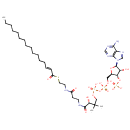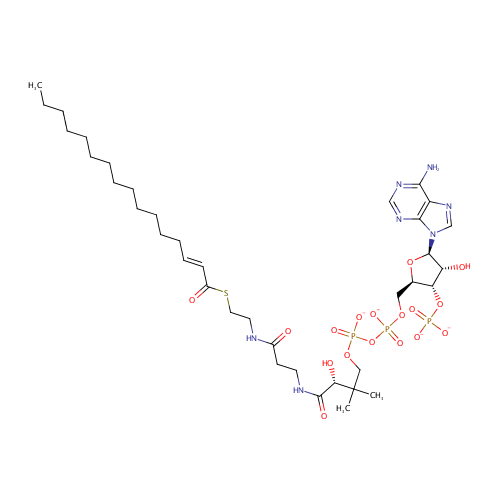|
Record Information |
|---|
| Version |
1.0 |
|---|
| Update Date |
1/22/2018 11:54:54 AM |
|---|
|
Metabolite ID | PAMDB000541 |
|---|
|
Identification |
|---|
| Name: |
(2E)-Hexadecenoyl-CoA |
|---|
| Description: | (2E)-Hexadecenoyl-CoA is an intermediate in fatty acid metabolism, the substrate of the enzyme enoyl-CoA hydratase [EC:4.2.1.17]. It is also the substrate of the enzyme trans-2-enoyl-CoA reductase [EC:1.3.1.38], in fatty acid elongation. (PMID: 1278159, KEGG) |
|---|
|
Structure |
|
|---|
| Synonyms: | - (2E)-Hexadecenoyl-CoA
- (2E)-Hexadecenoyl-Coenzyme A
- Trans-2-Hexadecenoyl-CoA
- Trans-2-Hexadecenoyl-Coenzyme A
|
|---|
|
Chemical Formula: |
C37H60N7O17P3S |
|---|
| Average Molecular Weight: |
999.895 |
|---|
| Monoisotopic Molecular
Weight: |
999.297923755 |
|---|
| InChI Key: |
JUPAQFRKPHPXLD-MSHHSVQMSA-J |
|---|
| InChI: | InChI=1S/C37H64N7O17P3S/c1-4-5-6-7-8-9-10-11-12-13-14-15-16-17-28(46)65-21-20-39-27(45)18-19-40-35(49)32(48)37(2,3)23-58-64(55,56)61-63(53,54)57-22-26-31(60-62(50,51)52)30(47)36(59-26)44-25-43-29-33(38)41-24-42-34(29)44/h16-17,24-26,30-32,36,47-48H,4-15,18-23H2,1-3H3,(H,39,45)(H,40,49)(H,53,54)(H,55,56)(H2,38,41,42)(H2,50,51,52)/p-4/b17-16+/t26-,30-,31-,32+,36-/m1/s1 |
|---|
| CAS
number: |
4460-95-1 |
|---|
| IUPAC Name: | (3R)-3-{[2-({2-[(2E)-hexadec-2-enoylsulfanyl]ethyl}carbamoyl)ethyl]carbamoyl}-3-hydroxy-2,2-dimethylpropyl ({[(2R,3S,4R,5R)-5-(6-amino-9H-purin-9-yl)-4-hydroxy-3-(phosphonatooxy)oxolan-2-yl]methyl phosphonato}oxy)phosphonate |
|---|
|
Traditional IUPAC Name: |
(E)-hexadec-2-enoyl-coa(4-) |
|---|
| SMILES: | CCCCCCCCCCCCC\C=C\C(=O)SCCNC(=O)CCNC(=O)[C@H](O)C(C)(C)COP(=O)([O-])OP([O-])(=O)OC[C@H]1O[C@H]([C@H](O)[C@@H]1OP(=O)([O-])[O-])N1C=NC2=C1N=CN=C2N |
|---|
|
Chemical Taxonomy |
|---|
|
Taxonomy Description | This compound belongs to the class of organic compounds known as long-chain 2-enoyl coas. These are organic compounds containing a coenzyme A substructure linked to a long-chain 2-enoyl chain of 13 to 21 carbon atoms. |
|---|
|
Kingdom |
Organic compounds |
|---|
| Super Class | Lipids and lipid-like molecules |
|---|
|
Class |
Fatty Acyls |
|---|
| Sub Class | Fatty acyl thioesters |
|---|
|
Direct Parent |
Long-chain 2-enoyl CoAs |
|---|
| Alternative Parents |
|
|---|
| Substituents |
- Coenzyme a or derivatives
- Purine ribonucleoside diphosphate
- N-glycosyl compound
- Glycosyl compound
- Organic pyrophosphate
- Monosaccharide phosphate
- 6-aminopurine
- Purine
- Imidazopyrimidine
- Monoalkyl phosphate
- Aminopyrimidine
- Imidolactam
- Alkyl phosphate
- Pyrimidine
- Primary aromatic amine
- Phosphoric acid ester
- Organic phosphoric acid derivative
- Organic phosphate
- N-substituted imidazole
- Monosaccharide
- Heteroaromatic compound
- Oxolane
- Imidazole
- Azole
- Thiocarboxylic acid ester
- Secondary alcohol
- Oxacycle
- Azacycle
- Organoheterocyclic compound
- Sulfenyl compound
- Thioether
- Thiocarboxylic acid or derivatives
- Carboxylic acid derivative
- Carboximidic acid derivative
- Carboximidic acid
- Hydrocarbon derivative
- Primary amine
- Organosulfur compound
- Organooxygen compound
- Organonitrogen compound
- Amine
- Alcohol
- Organic anion
- Aromatic heteropolycyclic compound
|
|---|
| Molecular Framework |
Aromatic heteropolycyclic compounds |
|---|
| External Descriptors |
|
|---|
|
Physical Properties |
|---|
| State: |
Solid |
|---|
| Charge: | -4 |
|---|
|
Melting point: |
Not Available |
|---|
| Experimental Properties: |
|
|---|
| Predicted Properties |
|
|---|
|
Biological Properties |
|---|
| Cellular Locations: |
Cytoplasm |
|---|
| Reactions: | |
|---|
|
Pathways: |
|
|---|
|
Spectra |
|---|
| Spectra: |
|
|---|
|
References |
|---|
| References: |
- Hinsch, W., Klages, C., Seubert, W. (1976). "On the mechanism of malonyl-CoA-independent fatty-acid synthesis. Different properties of the mitochondrial chain elongation and enoylCoA reductase in various tissues." Eur J Biochem 64:45-55. Pubmed: 1278159
- Kanehisa, M., Goto, S., Sato, Y., Furumichi, M., Tanabe, M. (2012). "KEGG for integration and interpretation of large-scale molecular data sets." Nucleic Acids Res 40:D109-D114. Pubmed: 22080510
- Keseler, I. M., Collado-Vides, J., Santos-Zavaleta, A., Peralta-Gil, M., Gama-Castro, S., Muniz-Rascado, L., Bonavides-Martinez, C., Paley, S., Krummenacker, M., Altman, T., Kaipa, P., Spaulding, A., Pacheco, J., Latendresse, M., Fulcher, C., Sarker, M., Shearer, A. G., Mackie, A., Paulsen, I., Gunsalus, R. P., Karp, P. D. (2011). "EcoCyc: a comprehensive database of Escherichia coli biology." Nucleic Acids Res 39:D583-D590. Pubmed: 21097882
|
|---|
| Synthesis Reference: |
Al-Arif, Adhid; Blecher, Melvin. Chemical synthesis of carnitine and coenzyme A esters of the b-substituted intermediates of hexadecanoic acid metabolism. Biochimica et Biophysica Acta, Lipids and Lipid Metabolism (1971), 248(3), 416-29. |
|---|
| Material Safety Data Sheet (MSDS) |
Not Available |
|---|
|
Links |
|---|
| External Links: |
|
|---|


